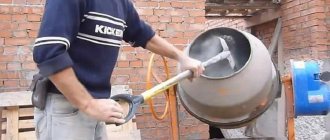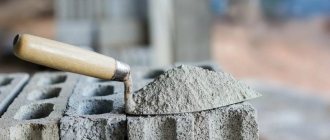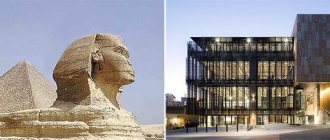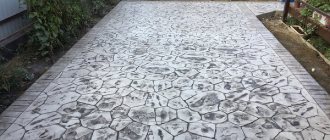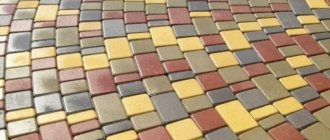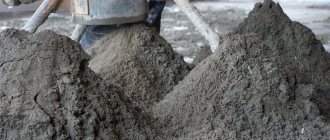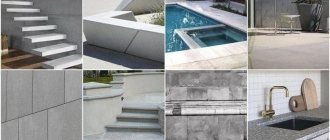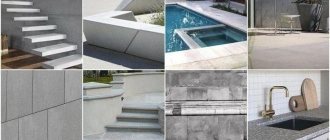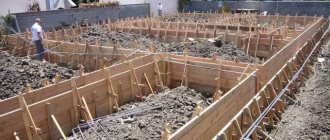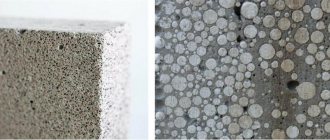During the Soviet period (especially the early one), aesthetics in the construction industry was not a priority. The main task was to build the maximum amount of housing at minimum costs. That is why standard designs and standard building materials were used everywhere.
Today the situation has changed radically - incomparably more attention is paid to the attractiveness of houses and apartments. At the same time, concrete, which remained the most popular building material, despite all its advantages, for a long time was uninteresting and mediocre from an aesthetic point of view. Therefore, many manufacturers began to improve it. So, for example, multi-colored concrete panels appeared that retained excellent performance qualities and had good decorative properties.
Purpose
Concrete is considered a boring material and is usually used for menial work. To make it sparkle with new colors, a new technique for making concrete blocks was developed.
Light-transmitting concrete or “Litracon” - thanks to its new properties, the material has begun to be actively used as decoration, for finishing buildings, partitions in rooms, and even for decorating lamps.
Hungarian architect Aron Losonczy experimented for a long time before he finally came up with transparent concrete. What does the new material consist of:
- cement;
- fine sand;
- fiber optic fibers;
- specialized additives for better formability.
Origin story
The search for revolutionary solutions in order to create building materials characterized by a designer appearance has led to the fact that at the moment concrete used in construction has many varieties, each of which has its own characteristics. Among the new products presented not so long ago is a unique transparent concrete that can transmit light while maintaining all the other “advantages” of its traditional counterpart.
The light-conducting material, called litrakone, was invented in 2001. Such concrete is not inferior in strength and other properties to conventional mixtures, but it looks unusual and very attractive. This building material allows you to radically transform the interiors of a room, providing them with visual airiness and lightness. Litracon walls are not completely transparent, but under certain lighting they make it possible to see the outlines of objects in the adjacent room. It is this quality that is highly appreciated by interior designers, stylists and architects, since they are now able to play with light and shadow, embodying their original ideas, the implementation of which was previously impossible.
In a very short period of time, innovative transparent concrete has become incredibly popular. So, today it has practically no competitors that simultaneously have similar indicators of reliability, durability, strength and beauty.
It should be noted that the author of the Litracon technology is the Hungarian architect Aron Loskonshi. He set himself the task of making walls that could transmit light while remaining as strong as possible. Therefore, it was decided to change the structure of the concrete itself, using light-conducting optical fiberglass in the mixture. It is obvious that the architect’s efforts were crowned with success, because concrete blocks created using his technology are today used to construct objects for a wide variety of purposes.
Types and characteristics
Transparent concrete that allows light to pass through
Basically, to create transparent concrete they use:
- high-quality Portland cement (PC) M300-M700;
- fine quartz sand 2-3 mm in size;
- granite or quartz chips.
To make the mixture easy to lay, various plasticizers are added to it, which reduce the ratio of water to cement.
The same transparency effect is produced by fiber optic fiber with a diameter of 0.25-0.5 mm. Lay it flat or create a design, logo or inscription. This fiber occupies only 5% of the total volume. The more light-conducting fibers in the composition, the more transparent the concrete, but the less strength.
The characteristics of transparent concrete are similar to regular concrete:
- Density 2050-2400 kg/m3;
- Compressive strength 20 MPa;
- Frost resistance up to F100;
- Thermal conductivity 0.1-02 W/(m °C);
- Water resistance W4-W6;
- Water absorption 8%;
- Flammability group NG;
- Sound insulation index 48-52 dB.
Translucent concrete is considered an environmentally friendly material with high resistance to ultraviolet radiation. To protect against silicate corrosion, the blocks are coated with special solutions.
Specific Features
We especially note the fact that Litracon contains exclusively safe, environmentally friendly ingredients that do not contain harmful impurities. Therefore, its use does not harm human health and the environment.
The disadvantage of the building material under consideration is that it cannot be obtained directly at the construction site of the construction project (in formwork). This is explained by the fact that the technique of layer-by-layer application of concrete mixture and fiberglass is used to create litracon. In addition, the finished blocks immediately after the solution has set require special processing to ensure high-quality light transmitting ability. Therefore, transparent concrete for construction is purchased in the form of ready-made blocks manufactured at specialized industrial enterprises.
Now litracon is actively capturing the market. Not only are entire structures built from it, but it is also used for decorative purposes and embodies original design ideas when decorating interiors.
As already mentioned, the apparent weightlessness of litracon does not in any way detract from its strength and reliability, resistance to low temperatures and exposure to open fire, immunity to ultraviolet rays and other advantages characteristic of ordinary concrete. At the same time, optical fibers in the composition of the material under consideration ensure the uniformity of the internal structure and the attractiveness of the surface of the finished products. This suggests that thick and thin blocks transmit light equally well, thanks to the unique properties of optical fibers.
Areas of use
Thanks to the high variability in the production of transparent concrete, its scope of application has expanded to infinity. The simplest use is, of course, in construction.
Ideal for interior or exterior decoration. It looks especially original instead of a window on the balcony. In the evening, light from the windows will create a beautiful ornament on the concrete, which will give the apartment a zest. Also suitable for the construction of partitions and stairs.
Transparent concrete is loved by ordinary consumers for creating:
- Benches;
- Unusual fountains;
- Night lights or decorative lighting;
- Illuminated walls.
Creating such creations of design thought may not be feasible due to the high price of one panel. In this case, you can create such concrete yourself.
DIY making
To create a high-quality block of transparent concrete, you should purchase special equipment. To increase the strength of the block, each layer of the composition is dried, processed, and then a new layer is laid. The procedure is repeated several times.
For those who do not have money for equipment, particularly smart craftsmen have already invented a method for making transparent concrete for “dummies.” For this you will need:
- One share of PC;
- 2.5-3 shares of fine sand;
- Light fiber (5% of the total mass);
- 0.5 parts water.
First, the ingredients are mixed to create regular concrete (it will turn transparent in the process). After you have mixed sand, cement and water, you must remember to mix the composition well for 6 minutes. Next, the sliding container is prepared and installation begins:
- A layer of concrete of 0.5-1 cm.
- Layer of fibers (press in a little).
- Leave to dry.
- Repeat the first points.
The number of layers depends on the desired block size. It should be taken into account that after making the block, it should be well processed on a machine - this is the only way to obtain ideal transparent concrete.
Prices for transparent concrete
The cost of light-transmitting concrete is quite high, so if you decide to use such material, it is better to order it from Europe. But due to the increased popularity, our manufacturers began to actively master the intricacies of producing transparent concrete.
Note! The production of transparent concrete is great for start-ups for new entrepreneurs. The market has not yet been developed and anyone can easily occupy a new niche.
So far, only two companies Litracon and Lucem are involved in the sale of light-conducting concrete in Russia. The product comes from Europe, so transportation costs are added to the price. The price of standard transparent concrete panels starts from 54,000 rubles and can reach 320,000 rubles, depending on the thickness of the block. Don't forget about delivery costs either.
Lytracon. Glowing concrete. Reviews
Litracon is a relative newcomer to our construction lexicon. The name “transparent” concrete was given by its creator, the Hungarian Aron Loshontsi, this is an abbreviation for “light transmitting concrete”, which means light-conducting concrete. He then created the Litracon company, which made this discovery world famous. A patent for the original innovation was filed and received in 2001, and today litracon is a coveted material for architects and designers, causing constant delight in everyone who has seen products made from it.
Litracon is a wonderful material with excellent prospects
Perhaps you have already come across photos of “transparent” walls, behind which you can see the silhouette of a person? This is exactly litracon, an interesting modern material. It is made from fine-grained concrete and fiberglass scraps (they are minimal - from 2 microns to 2 mm in diameter), the scraps are located perpendicular to the surface of the slab. The material retains all the properties of concrete - frost resistance, fire resistance, load-bearing walls can be built from it, and at the same time creates the impression of light and transparent thanks to fiberglass. By the way, glass fibers in concrete, despite the visual multiplicity, are only no more than 5%.
Litracon, which is illuminated with additional light sources, evokes a special response. Projects with interior partitions made from this material are excellent; it simply fits organically into modern postmodern interiors and high-tech style.
Designers use miracle concrete to design furniture, vanity units, bathtub linings, etc. The author of the intriguing material, Loshontsi, created the “Litrocube” lamps, consisting of two cube blocks, which glorified his inventive mind. One lamp weighs 10 kg, but you can’t tell by looking at it. They are produced in the following colors: white, gray, black, price approximately 570 euros.
Litracon cost?
As a matter of fact, the cost of this material today is its biggest disadvantage. Designers come up with original solutions, for example, you can build blind utility rooms without windows from this material, and it will look simply excellent, but who now dares to build such an expensive shed on their summer cottage? Of course, technology does not stand still, and sooner or later the material will become cheaper, become affordable even for the average pocket, and people will fill their homes with it and build administrative, entertainment, and medical buildings.
In the meantime, venerable architects and equally famous concerns are making their dreams come true from transparent concrete. The world-famous Zaha Hadid, who often designs buildings for which humanity has not yet invented materials for implementation, was inspired by the litracon.
She created the central building of the BMW concern in Leipzig. The structure won the German Architecture Prize in 2005. Also in Aachen, the facade of one of the buildings is covered with transparent concrete, the lighting is controlled by a computer, and the wall serves as a delightful light show screen.
In the USA, they expressed the opinion that litracon is the best choice for fencing administrative buildings. It is already used in elements of numerous buildings in Sweden, a number of other European countries, as well as ultra-modern Japan. It is confidently called a wonderful material of the future.
You can also read the article about nanoconcrete.
